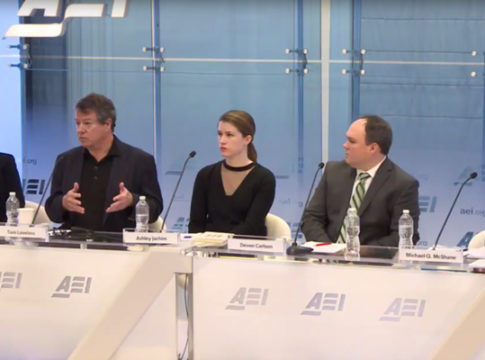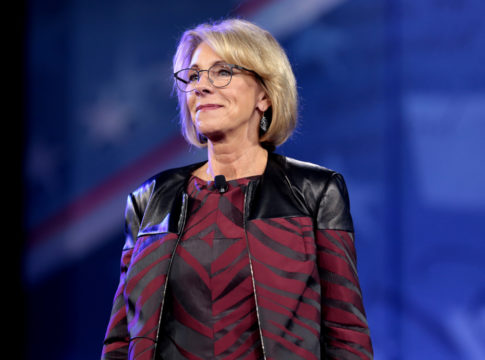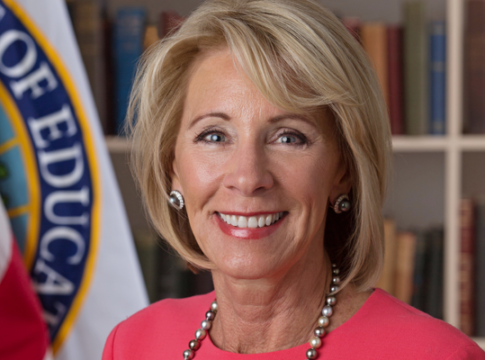
If you pay even a little attention to education policy, you’ve probably seen it: that oversized “WHITE SUPREMACIST” banner-on-a-bedsheet that was unmissable in photos of U.S. Secretary of Education Betsy DeVos’ recent speech at Harvard. The photo ran yet again just the other day, accompanying an EdWeek story about the challenges DeVos has encountered in using the bully pulpit. But, today, let’s set aside the Beltway stuff to talk a bit about that sign and what lately strikes me as the remarkably promiscuous use of that term—white supremacist—in education circles. I’m going to do my best to do so with respect for the letter and spirit of the document I signed this spring, “Fostering a Productive Dialogue on Race, Social Justice, and School Reform.”
First off, let’s keep in mind that “white supremacist” is (and should be) an extraordinarily potent term: It’s a word that has been used to denote truly execrable people, those who trade in racial hatred and fantasies of an ethnocentric hierarchy in which whites reign supreme. In the 19th and 20th centuries, white supremacy spawned fever dreams of “scientific racism,” yielding the junk science of eugenics to justify discriminatory agendas rooted in claims of racial superiority.
None of that describes DeVos. She has devoted thousands of hours and millions of dollars to fighting for her vision of educational betterment—especially for minority children in high-poverty communities. She may be wrong, but it’d be hard to make the case that her efforts are white supremacist. After all, even the probing, vicious, largely unprecedented coverage of her nomination never offered up any suggestion that DeVos has ever written or said anything to that effect.
Now, of course, none of this means that anyone should feel obliged to like, respect, or agree with DeVos. One can loathe her. One can venomously denounce her agenda. But it is extraordinarily difficult to understand how anyone—particularly someone in an audience at an august, Ivy League university—can think it’s fair to label her a “white supremacist” . . . or stand by while others do so. And yet DeVos walked off the stage at Harvard to slanderous chants of “What does white supremacy look like? That’s what white supremacy looks like!” I keep waiting for some on the responsible Left to make this point. Instead, the silence is deafening. Perhaps no one feels a need to say anything because the phrase is becoming omnipresent wallpaper in the education debates, just one more familiar partisan epithet.
When a phrase like “white supremacy” is bandied about so lightly, the most straightforward response for many on the Right (and even some in the middle), is to conclude that anyone who wants to shrink the federal government, supports school vouchers, or is skeptical of affirmative action risks being stamped a “white supremacist.” At that point, of course, the phrase becomes just one more politicized mantra. Figuring that they may be branded a “white supremacist” regardless of what they think, say, or do, those on the Right have less and less cause to take the phrase at face value. This makes it more difficult to stigmatize actual white supremacists. Meanwhile, I have to wonder if this “normalization” by the “anti-racist” Left is also contributing to the reported uptick of interest in real white-supremacy groups on campus. Capricious accusations of “white supremacy” may just be recasting these pathetic, despicable, marginalized losers as rebels unafraid to stand up to politically correct bullies.
I’m struck that so many responsible leaders in education have remained conspicuously silent in the face of all this. After all, more than 100 self-avowedly anti-racist education leaders rallied last year to sign a letter denouncing Robert Pondiscio for penning a single column suggesting that education reform had become dominated by fealty to progressive nostrums. Pondiscio wrote, “There is an unmistakable and increasingly aggressive orthodoxy in mainstream education reform thought regarding issues of race, class, and gender. And it does not include conservative ideas.” This was enough to rouse a frenzied, blistering denunciation, with the letter’s signatories furious that Pondiscio’s words posed a threat to the “intellectual generosity, coalition building, and diversity necessary to drive real progress.”
Well, okay. But, if that’s all true, then I’m wondering why those same voices have yet to speak up now—even if only to say, “We disagree vehemently with Secretary DeVos on school vouchers, cuts to federal spending, and the whole Trump agenda, but calling her a ‘white supremacist’ is out of bounds and antithetical to what we believe in.” After all, indiscriminate, high-profile charges of “white supremacism” seem far less “intellectually generous” and far more destructive to coalition-building and racial comity than anything Pondiscio wrote. In fact, I’m reminded of that document many of us signed this spring, which pledged, “At times of passionate disagreement, we will affirm each other’s sincere and heartfelt dedication to improving education and expanding opportunity for young people.” This might be a good time to put that promise into practice.
— Frederick Hess
Frederick Hess is director of education policy studies at AEI and an executive editor at Education Next.
This post originally appeared on Rick Hess Straight Up.





